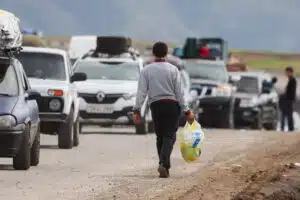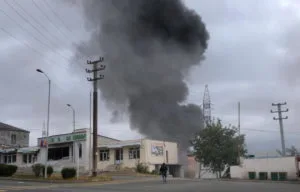Brussels – It has disappeared from the headlines of European newspapers for months. Still, the crisis between Armenia and Azerbaijan has never been resolved after the sudden and extremely harsh military action of the Azerbaijani army in the Nagorno-Karabakh region conducted in a single day between September 19 and 20, 2023. This morning (Feb. 13), four Armenian soldiers were killed in a firefight with Baku forces along the border, following yesterday’s (Feb. 12) gunfire on the Armenian side reported by Azerbaijan but not confirmed by Yerevan. We risk, once again, an escalation of tension that does not favour the stabilization of the South Caucasus nor the European Union’s relentless efforts to push forward the peace process between two countries that have been at war—fought or frozen—or more than 20 years.

“We discussed the regional situation and the normalization process between Armenia and Azerbaijan, including the latest border incidents,” announced the EU High Representative for Foreign Affairs and Security Policy, Josep Borrell, at a press conference with Armenia’s Foreign Minister, Ararat Mirzoyan, at the end of the fifth meeting of the EU-Armenia Partnership Council: “Shootings on Azerbaijani soldiers are regrettable, but the response seems to be disproportionate.” While “investigations” into what happened yesterday have been confirmed by Yerevan, in Brussels, there is no lessening of the Union’s “full” commitment to a “sustainable and lasting peace, based on sovereignty, inviolability of borders, and territorial integrity,” Borrell strongly reiterated. In the wake of the “ethnic cleansing” in the former Armenian enclave in Azerbaijan—as Minister Mirzoyan recalled it, according to the line shared by the EU Parliament—the Union has not only strengthened the EU mission in Armenia but also allocated just today “additional €5.5 million in humanitarian aid” to support displaced people from Nagorno-Karabakh, “adding to the €12.2 million already provided in September.”

(credits: Alain Jocard/Afp)
This morning’s incident—which Baku explicitly calls a “revenge operation”—in the southern Syunik region is the most serious since Azerbaijan retook Nagorno-Karabakh, causing the exodus of ethnic Armenian population toward Yerevan (more than 100,000 refugees poured into a country of 2.8 million). Contacts between Brussels, Yerevan and Baku to arrive at a comprehensive peace agreement have not progressed for months. An agreement that Armenia’s Prime Minister, Nikol Pashinyan, from Strasbourg, had projected for late 2023 if only Azerbaijan’s President, Ilham Aliyev, had decided to stop obstructing the process as he did at Third European Political Community Summit last October 5 in Spain (when he deserted the quintet with the president of the European Council, Charles Michel, the German chancellor, Olaf Scholz, and the French president, Emmanuel Macron).
In the face of these difficulties, however, work continues on a rapprochement with the EU on the part of Armenia, which has remained politically and diplomatically burned by the “betrayal” of its historic Russian ally in the fall war events in Nagorno-Karabakh (where Moscow’s peacekeeping troops took no action against the Azerbaijani army). “We know there is room to develop the potential of this agreement after you have decided since October to work to move closer to the Union,” Borrell stressed, explaining that “we have explored ways to strengthen relations.” In particular, “we have decided to start working on an ambitious new agenda for the partnership,” which “sends a strong message and provides a roadmap for the entire region,” including the possibility of Schengen visa liberalization for Armenian citizens. “On your part, there is strong interest; I encourage you to strengthen reforms to make progress in this direction,” is the EU High Representative’s exhortation.
The conflict between Armenia and Azerbaijan
Between Armenia and Azerbaijan, a frozen war has been going on since 1992, with recurring outbreaks of armed violence centred in the separatist region of Nagorno-Karabakh. The most serious in recent years was in October 2020: in six weeks of conflict, nearly 7,000 civilians died before the ceasefire that forced Armenia to cede large portions of territory in Nagorno-Karabakh. After a year and a half, the situation heated up again because of some shooting at the border in late May 2022, which continued in parallel with the high-level talks prompted by the EU Council president until the resumption of hostilities between Armenia and Azerbaijan in September, with mutual accusations of bombing military infrastructure and trespassing by ground troops. The lack of direct monitoring of the situation on the ground by Russia (which, until the outbreak of war in Ukraine, was the primary international mediator) led to the decision to implement an EU mission, with 40 experts deployed along the Armenian side of the border until December 19, 2022. A week before the end of the mission, however, Azerbaijan informally blocked—through the presence of armed pseudo-environmental activists—the Lachin corridor, putting in place substantial restrictions on the transit of essential goods such as food and medicine, gas, and drinking water. On January 23, 2023, came the decision of the EU Council to establish the European Union Civilian Mission in Armenia (EUMA) as part of the Common Security and Defense Policy, but tensions escalated again on April 23 after Baku decided to formalize the closure of the strategic link through a checkpoint. From Brussels came the condemnation of EU High Representative Borrell before resuming discussions in May and a new round of high-level negotiations on July 15 between Michel, Armenian Prime Minister Pashinyan, and Azerbaijani President Aliyev.

Esplosions in Nagorno-Karabakh
Alternating diplomatic efforts and tensions on the ground also endangered the EU observers present in Armenia since Feb. 20, 2023, to contribute to stability in the border areas. On August 15, an EUMA mission patrol was involved in a shooting by unclear contours (both sides, Armenian and Azerbaijani, blamed each other), with no casualties. Only a month later, it appeared that the situation might slowly stabilize, with the passing of the first convoy with international aid on September 12 via the Ağdam-Askeran route and then, on September 18, the unblocking of the Lachin Corridor after almost nine months of humanitarian crisis. Not even 24 hours later, however, the Azerbaijani bombings began against the separatist enclave, which—due to the disproportion of forces on the ground—resulted in the ceasefire and rapid surrender of the Stepanakert military, with the total takeover by Baku soldiers.
English version by the Translation Service of Withub




